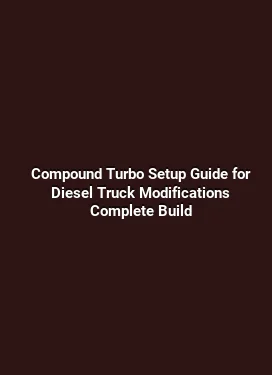The Knock Threshold: Using Octane Rating to Push Your Engine's Limits
Understanding Knock Threshold and Octane Context

Engine efficiency and performance hinge on the precise timing of combustion. The knock threshold refers to the point at which unintended autoignition or detonation becomes audible or detectable within the cylinder. When detonation occurs, the pressure waves collide with the normal flame front, producing shock-like events that can damage pistons, rods, and valves if sustained. The octane rating of fuel plays a central role in resisting this detonation. Higher octane fuels resist pre-ignition more effectively, allowing the engine to operate at higher compression ratios, advanced ignition timing, and increased boost in forced-induction scenarios without triggering knock.
From a materials and thermodynamics perspective, the key is controlling the autoignition tendency of the air-fuel mixture. In high-compression or turbocharged engines, the mix reaches peak temperatures more rapidly. If the fuel-air mixture autoignites ahead of the spark plug, the resulting mis-timed pressure surge reduces power, increases thermal stress, and can degrade engine life. Carefully selecting fuel with an appropriate resistance to knock is a foundational step in achieving both performance and longevity.
Fuel Quality and How It Shapes Performance
Fuel quality is not a single-number attribute; it is a composite of octane rating, energy content, and additives that clean, protect, and lubricate the system. In practice, higher octane fuels generally provide greater resistance to knock, enabling higher compression ratios, more timing advance, and greater peak power. However, octane alone does not guarantee higher efficiency or power. The engine management system must exploit the fuel’s properties through calibrated spark timing, boost control, and variable valve timing to extract the full potential.
Modern engines often use knock sensors that monitor detonation in real time. When knocking is detected, the engine can retard timing to preserve safety, potentially sacrificing some horsepower. A well-tuned system, combined with suitable fuel, ensures that timing remains near the optimum point for power while maintaining a comfortable safety margin. This dynamic relationship means that the same engine can exhibit different performance characteristics depending on fuel specification, ambient temperature, and altitude.
How Octane Ratings Are Determined and What They Really Tell You

Octane rating is determined by how resistant a fuel is to autoignition under specific laboratory conditions. In the domestic market, the average regular, mid-grade, and premium designations correspond to different knock resistance profiles. In practice, the practical impact of octane is most evident when engines operate at high compression or with forced induction. A higher rating allows you to run with more aggressive timing and higher boost without crossing the knock threshold. It is important to note that octane rating is not a measure of energy content or fuel economy by itself. A higher octane fuel does not inherently produce more energy; it provides a greater safety margin for operating conditions that favor detonation resistance.
Engine Design and the Interplay with Octane Tolerance
Engine design determines how sensitive an engine is to detonation. Direct-injection, turbocharged, and high-compression naturally aspirated platforms require different levels of knock resistance. A high-compression engine benefits from fuels with greater resistance to preignition because the compression process itself raises the temperature and pressure within the cylinder. In turbocharged setups, the added pressure further elevates the risk of knock, making octane selection crucial for sustaining performance under high-load conditions. Conversely, engines designed with advanced cooling, robust pistons, and reinforced connecting rods can tolerate a wider range of fuels, but still benefit from precise fuel selection during peak power runs.
Choosing the right fuel becomes a dialogue between the engine’s tuning and the environment in which it operates. For street driving, a balance between performance and economy is often achieved with a moderate octane rating. For track work or performance testing, a higher octane variant can unlock additional timing and boost headroom, provided the rest of the system can tolerate the increased stresses and temperatures.
Practical Scenarios: From Everyday Driving to Track Sessions
In everyday driving, many engines will run efficiently on regular-grade fuels, especially if the ECU maps timing conservatively to prevent knock. When approaching higher performance modes or climbing grades, you may notice an improvement in throttle response, acceleration feel, and peak power when switching to a higher octane fuel. On the track, however, the difference becomes more pronounced. The driver can exploit the additional knock resistance to run advanced timing maps at higher boost levels, achieving higher horsepower without triggering detonation. It is essential to monitor engine behavior through data logging and, if available, factory diagnostic telemetry to verify that the knock threshold remains safely above the operating conditions.
For engines with adaptive or programmable ECU capabilities, the process often involves a methodical map refinement: establishing a baseline with a conservative timing map, incrementally advancing timing while monitoring knock sensors, and observing the response in terms of power delivery and intake temperatures. Fuel quality, ambient temperature, and altitude should be considered as they influence the actual knock margin. Small, incremental steps reduce the risk of piston damage or exhaust valve stress while uncovering the true performance envelope of the setup.
Testing, Data, and Real-World Measurements
Reliable assessment of knock threshold requires structured testing and data interpretation. In a controlled environment, you can perform a series of pulls on a dynamometer to evaluate how different octane fuels affect peak power, torque, and thermal load. Recording engine knock events via sensor data and correlating them with timing changes helps identify the optimal balance between performance and safety. The use of data-logging software enables post-test analysis of ignition timing, air-fuel ratio stability, and cylinder pressure indicators. With this information, you can map the operating window where the engine produces the most consistent power without crossing the knock threshold.
Ambient conditions matter. Hotter ambient temperatures lower air density, which can influence effective octane usage and the tendency for detonation. Humidity and altitude also impact air charge and cooling efficiency. When planning performance tests, replicate the expected operating environment as closely as possible to avoid misinterpreting the engine’s knock resilience. A comprehensive approach combines on-vehicle testing with controlled lab-style measurements, ensuring the collected data reflects real-world operating curves rather than isolated bench readings.
Optimizing Spark Timing and Boost for Maximum Margin
Optimizing timing without compromising reliability is a central objective. The goal is to push timing forward enough to maximize post-torque torque curves while keeping knock margin above the critical threshold. In forced-induction engines, boost control interacts with octane tolerance. A higher octane fuel often allows a modest boost increase without triggering knock, but the relationship is non-linear. The best practice is to apply conservative boost increases first, verify stability through multiple gear pulls, and then consider further refinement if the data shows a healthy margin against detonation.
Keep cooling performance in check. As timing and boost rise, so do cylinder temperatures. Efficient charge cooling, intercooling, and adequate lubrication help maintain integrity under elevated pressures. If temperatures rise toward critical levels, even with high-octane fuel, you may need to dial back timing or boost to preserve long-term reliability. A holistic approach that includes cooling system improvements, intake air management, and fuel delivery stability yields the most consistent performance gains without compromising durability.
Maintenance, Quality Assurance, and Long-Term Reliability
Fuel choice is only one facet of reliable high-performance operation. Regular maintenance of ignition systems, sensors, and fuel delivery components is essential. Worn spark plugs can distort ignition timing, leading to misfires that masquerade as knocking behavior or reduce perceived performance. Clean injectors and a stable fuel pressure supply are important for consistent air-fuel delivery, particularly at higher rpm and boost levels. A well-maintained engine, paired with appropriate fuel, preserves the integrity of pistons, rings, and valves over the long haul.
Lean-running conditions or rich misbalances can complicate the detection of genuine knock events. The diagnostic strategy should include checking for abnormal combustion indicators, verifying fuel trims, and ensuring the knock sensor system is calibrated to the specific engine. In some high-performance builds, calibration of knock thresholds is a deliberate part of the tuning process. This involves mapping around potential detonation windows while preserving power and drivability across operating conditions.
Fuel System Hygiene and Additives
Beyond octane, fuel cleanliness matters. Contaminants or degraded additives can alter combustion characteristics, sometimes mimicking knock-like behavior or reducing the efficiency of the fuel-air mix. Regular fuel system cleaning, proper storage, and the use of reputable fuel brands help maintain consistent performance. In some performance contexts, engineers may choose detergents or octane-boosting additives that improve combustion stability, but these should be selected with care to avoid adverse reactions with the engine or fuel system materials.
Ultimately, the interplay between octane, timing, and boost is a dynamic system. Maintaining a robust maintenance schedule, closely monitoring engine health through diagnostics, and adhering to manufacturer specifications will help ensure that you can consistently push the engine within its safe operating envelope while achieving your performance goals.
Environmental Considerations and Real-World Implications
Higher octane fuels can influence emissions profiles through changes in combustion efficiency and temperature. While maximizing performance, it is essential to remain mindful of environmental impact and compliance with local regulations. Many modern engines are designed to optimize emissions across a range of operating conditions, and pushing the mechanical envelope should be balanced with responsible driving practices. In some regions, the availability of higher octane fuels is limited, requiring careful planning of tuning strategies and fuel choices to avoid compromising reliability during typical daily use.
From a practical perspective, vehicle owners should maintain a clear understanding of their goals. If the aim is occasional track performance, investing in higher octane fuel and a tuning strategy that preserves reliability during laps and cool-down periods is sensible. For daily drivers, a more conservative approach may yield better overall efficiency and longevity while still delivering meaningful improvements in throttle response and mid-range torque under demanding conditions.
Closing Considerations: Building a Safe Performance Roadmap
A robust performance roadmap begins with a clear evaluation of the engine’s design limits, the available octane options, and the intended use-case. A staged approach—starting with safe timing, validating with data, and progressively refining boost and fueling—reduces risk while revealing the true potential of the setup. Real-world testing, paired with careful monitoring of knock margins, cylinder temperatures, and fuel stability, helps ensure that performance gains do not come at the expense of reliability or long-term durability.






